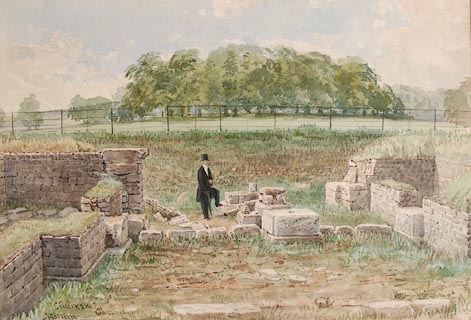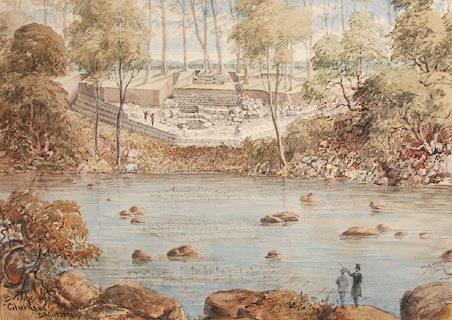




placename:- Cilurnum
placename:- Walwick Chesters
 goto source
goto sourceGentleman's Magazine 1851 part 2 p.384 "..."
"... Cilurnum, now Walwick Chesters, the seat of the Messrs. Clayton,*offers the first example of the internal arrangements of one of the stations upon the line of the wall. A suite of at least ten rooms has been here laid open. The"
"*I cannot name these gentlemen without acknowledging the very courteous and kind attentions we received from them during our tour of the Wall. By their friendly services we were enabled to inspect comfortably and leisurely some of the most important localities and monuments. The antiquarian intelligence, classical learning, and liberality of Mr. John Clayton is gracefully recorded by Mr. Bruce in the dedication of his book. Mr. Nathaniel Clayton, the elder brother, will not, I hope, be offended by my introducing here a reminiscence of his schoolfellow, Lord Byron, which [continued on p.385] my fellow-traveller, Mr. Price, has identified as applied to him: "Clayton was another school-monster of learning, and talent, and hope; but what has become of him I do not know. He was certainly a genius." - Life, Letters, and Journals of Lord Byron, page 21. Murray, 1838."
item:- inscription, roman; roman inscription
 goto source
goto sourceGentleman's Magazine 1851 part 2 p.385 "floor of one of the largest of these is supported by no less than forty-eight columns of masonry of about two feet square; another room has twenty-four; in a third the floor is laid upon pillars of tiles interspersed with some of stone, a few of which had apparently previously joined the capitals of columns in some decayed or destroyed building; the floors are composed of large slabs of stone. These apartments were heated by hypocausts, and many of them have been provided with double doors."
"The houses both here and at Borcovicus are pretty clearly indicated in the pasturage, and it would be raising expectation too high or promising too much were I to say that, as at both these great stations the foundations of the buildings appear to have been undisturbed, it is probable pretty correct plans of the entire distribution of the areas might be obtained by excavations. On the outside of these castra, chiefly on the south, were villas and houses, indications of which are so numerous as to warrant our using the terms villages and towns. Beyond these are the burial-places, where the greater part of the inscriptions are found. It is in these memorials we read much of the history of the places. To cite, for example, one found at Chesters many years ago. It commemorates the restoration of a temple, which had become decayed through age, by soldiers of the second wing of the Astures, a people of Spain, in the time of Elagabalus, under the consulate of Gratus and Seleucus, answering to our A.D. 221. Now upwards of one hundred years after this date we find the same wing of the the Astures located here, a coincidence between the Notitia and inscriptions which occurs frequently along the line of the wall. The great importance of monuments such as these must beget a desire that the stations on the line of the wall should be thoroughly excavated, as it is more than probable there are numerous inscribed stones still remaining buried, especially when it is considered that those hitherto discovered were brought to light through accidental circumstances, and not from intentional research. At Chesters Mr. Clayton has preserved numerous interesting remains discovered there and at Housesteads. The following mutilated inscription is worthy of notice, as recording a soldier of Pannonia (Dagvaldus) and a female, Pusinna, probably a near relative:"
"D. M.
.. DAGVALD . MI ..
.. PAN . VIXIT . A ..
.. PUSINNA ..
.. XXIT . VI ."
 goto source
goto sourceGentleman's Magazine 1851 part 2 p.387 "..."
"... At Chesters he [Hutton] approaches the walls of Cilurnum; he enters, and is in the midst of dwelling-houses, roofless and dilapidated, but still sufficiently perfect for him to form a good notion of their arrangement, the distribution and peculiarities of the apartments, and indeed the general plan of the castrum, although it is but partially excavated. He crosses thresholds worn by the tread of Roman feet, and as he walks through room after room upon the strong flagged pavements, built as if to last for ever, he revolves in his mind the revolutions of empires and the courses and vicissitudes of human affairs. A city lies buried before him. During a brief period in the world's age the scene around him was full of life, enterprise, and hope; a dense population has spread along the hills from the Tyne to the Solway; camps, villas, and towns marked its growth; some few centuries later nature"
 goto source
goto sourceGentleman's Magazine 1851 part 2 p.388 "entombed their remains, and solitude again resumed her dominion. A river god, the genius probably of the North Tyne, which rolls among rocks and woods by the side of the station, is now enshrined in the mansion at Chesters with numberless other vestiges of ancient Cilurnum and of Borcovicus, the great station next but on towards the west. "The Astures," says Hodgson, "in exchanging the sunny valleys of Spain for the banks of the tawny Tyne, might find the climate in their new situation worse, but a lovelier spot than Cilurnum all the Asturias could not give them.""
item:- inscription, roman; roman inscription
 goto source
goto sourceGentleman's Magazine 1851 part 1 p.152 "..."
"Another class of inscriptions, more numerous and not less interesting, are those relating to worship. They embrace, as may be supposed, a wide range of divinities, the objects of adoration of the various troops stationed along the wall, from Jupiter, the Optimus and Maximus, down to Epona, the protectress of horses. They are usually inscribed on altars, which were set up not only in temples, but also in the open places, and even in the fields. Hodgson states that within the limits of one modern parish four important fortified places were furnished with temples to different deities; and he adds that he felt it difficult to refrain from both admiring the piety and pitying the superstition that reared them. Sometimes the dedications are"
placename:- Cilurnum
 goto source
goto sourceGentleman's Magazine 1851 part 1 p.153 "accompanied with sculpture, as in the case of the great Mithraic group found at Housesteads. We are disposed to think the fragment shown in the annexed cut may have belonged to a"
 click to enlarge
click to enlargeG851E10.jpg
"kindred myth, especially as in the representation given by Hodgson there appears upon the pedestal what would seem to have been a serpent entwined round the legs of the bull. This fragment, which was dug up on the site of Cilurnum, is in a fine-grained sandstone, and measures six feet two inches in length."
placename:- Cilurnum
placename:- Celumno
placename:- Cilurno
item:- bridge
 click to enlarge
click to enlargePR0794.jpg
In the centre of the composition a gentleman wearing a top hat stands with his left foot resting on a block of fallen masonry in the gap between two substantial stone constructions. Beyond the metal fence behind him stretches flat parkland with distant hills beyond.
signed &inscribed at bottom left:- "D Mossman 'Cilurnam' Chesters"
item:- Tullie House Museum : 1889.8.7
Image © Tullie House Museum
item:- bridge
 click to enlarge
click to enlargePR0795.jpg
The remains of the bridge at Chesters, enclosed by woodland, with two men standing at the perimeter, viewed from the far bank of the river beneath the surface of which submerged sections of masonry are visible. To right of composition, in the foreground, stand two men, one of whom gestures with his cane.
inscribed &signed at bottom left:- "Bridge of 'Cilurnam' D Mossman"
item:- Tullie House Museum : 1889.8.8
Image © Tullie House Museum
